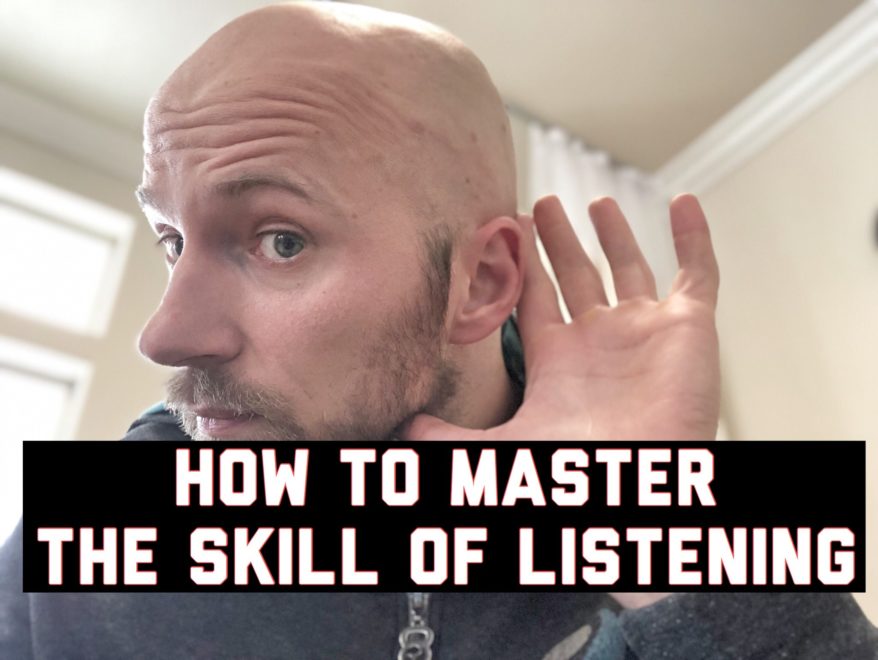‘You are such a good listener.”
These are a sample of things I hear from patients, friends, and acquaintances on a regular basis.

My listening skills are likely the largest contributing factor to attaining buy-in, building rapport, and establishing connections. Listening is essential if you want people to like you. And if they don’t like you, well, good luck!
But I wasn’t always this way.
When I was a young buck, I was shy, quiet, and unsure of myself. I most certainly had friends, but most connections were superficial. Because I was quiet, many times when I spoke in a group my words would go ignored. I struggled to form the deep bonds that we as humans crave. A lack of connection can create a void within us.
I wanted that void to fill, so I desperately needed to cultivate a skill. I didn’t need to talk louder, assert myself, or become the most interesting man in the world.
I needed to listen.

In order to establish a meaningful bond with someone, both parties have to feel three things. These are three feelings we all crave when connecting with someone:
- Heard
- Understood
- Important
Think about the last meaningful interaction you’ve had with someone you really hit it off with. I have zero doubt in my mind you felt almost all of these feelings. Cultivating these feelings require listening intently with genuine (yes, you can’t fake it) curiosity, interest, and focus. Eliciting these feelings is essential to creating behavior change for our clients pursuing health and wellness, as well as developing close bonds to these we want in our personal lives.
Talking about ourselves is beyond intrinsically rewarding. Research shows that it’s one of our favorite things to do, activates similar brain regions experienced with pleasurable food and sex, and we are willing to forego monetary rewards in favor of talking about ourselves¹.
Dopamine is a helluva drug, and listening can make you a dealer of Scarface proportions.

Sadly, this research is a double-edged sword. Because we like talking about ourselves so much, we often do so in lieu of listening to others. Listening has become a lost art. Medical record taking has made interactions focus more on data collection than rapport building, social media has made us self-absorbed, and our modes of communication have devolved from nuance to matter-of-fact text.
We no longer feel heard, understood, and important by others, so we try to create that for ourselves.
Imagine a scenario where you are talking with someone who only talks about themselves. Perhaps they are self-fulfilling those intrinsic needs at best, or narcissistic at worst. Those people where you can’t get a word in, nor do they ask about you. These interactions also leave a lasting impression, yet in the worst way. A lasting impression of disconnectedness and loneliness.
Now I’m not saying you should never talk about yourself. Self-revealing is critical to connect with people and establish common interests. But if you want to create memorable connections with others, you must go next level. I want you to eliminate the need for the person to douse themselves in dopamine. I want you to make the people you interact with personally and professionally feel heard. Feel safe. Feel connected. Feel important.
The key to creating these feelings, my dear fam, is through listening. Listening is a skill, and we are about to embark on a skill building journey.
Here’s how I approach it.
Table of Contents
The Most Important Listening Key
Is…
Give a shit.

Yes, you can’t fake this listening thing. You can’t pretend to feign interest in what someone has to say. The most inept communicators and self-absorbed may not be able to read your disinterest, but many will. Not caring leads to a lack of connection building, which will neither make you any friends nor help potential clients. You won’t make any fam…fam.
But what about those boring talkers, or people you aren’t wholly interested in?
I get it. You aren’t going to vibe with everyone you come into contact with. Not everyone will become OG status in your life, and that’s totally ok. That said, you can’t find that out unless you give the other person a chance. A good listen if you will.
For those who may be, eh, not so interesting, I play a little game. You can play this too. Pretend you are a detective or a secret agent. I prefer James Bond.

Your mission, if you choose to accept it, is to find out something interesting about the person you are conversing with. What makes them tick? What hopes and dreams they have? Anything!
If you’ve carried out your mission, and you did not find a single area of common ground, mission abort, fam. Mission abort.
Communication Components
Pending the medium, most interactions are a mix of both nonverbal and verbal communication.
Nonverbal would include the following components
- Body language
- Vocal tone
and verbal would be the actual words said.
Now I’m sure you all are wondering, how much communication is nonverbal, and how much is verbal?
The answer is rather disappointing. We simply don’t know. The more likely answer though: it depends.
Much of the way we communicate depends on the medium. In person communication likely has a healthy mix of three, whereas a phone call eliminates the body language component, and texting relies pretty much explicitly on verbal (emoji’s can help bridge the gap to an extent, but they are no replacement).
Context matters, yet all components can be manipulated in a manner to become a more effective listener. Let’s look at how to do that.
Body Language
Using friendly body language is essential to making people feel heard.
Many different body postures and actions can be used to demonstrate and enhance your listening capabilities. Here are some of the things I use.
Eye Contact
Eye contact is by far the number one way you can show someone that you are listening. It’s the major nonverbal way that us humans establish connections with one another. Utilizing eye contact (at least in the west), provides cueing to the other person that your focus lies solely on them, right where it ought to be.
Now, too much eye contact can be creepy. You don’t want to stare at someone as though you are a predator moving in for the kill.

Thus, you should plan on breaking eye contact when listening someone when it feels natural. I personally follow the lead of the person who I am speaking to. If they break eye contact with me, I will hold eye contact for just a bit longer, then break away myself before re-engaging. I will also do this delayed break when there is a natural lull in conversation, and before I speak.
Open Posturing
Closing off our posture (i.e. crossed arms, crossed legs) can subconsciously indicate either that we are not receptive to communication or are uncomfortable in the current scenario, as though we are protecting ourselves.
Listening requires the exact opposite strategy. Open posturing cues people to proceed with interacting, as we are open to what they are sayin’ (if you know what I’m sayin’).
This doesn’t mean that we go the exact opposite of being all crossed up. You probably don’t want to be man spreading, fam. That’s more of a dominant posturing, which we don’t want to convey as listeners. Instead, uncross your legs and arms, keeping your palms visible, and lean slightly inward toward the person. Make yourself come off as a safe, and slightly vulnerable person.

Orientation
Orientation is the direction you are facing someone, and you likely want to pick a direction that makes the other person most comfortable.
I forget where I read this, but there may be gender differences in terms of what are appropriate orientations to face someone. Because females generally like communicating and whatnot to connect, directly facing a woman may be useful in establishing rapport. Doing that with bros on the other hand, might come off as threatening. Think back to the Caveman days. Directly facing your opponent might be a way to signal dominance, which we don’t want in this case.
Personally, I’ve found where you should orient yourself is incredibly individualized. Where I would typically start is orienting according to the gender differences mentioned, and watch for cues from the other person in terms of if they are comfortable or not. If you notice the other person crossing his or her arms, legs, and becoming short with talking, you probably want to change your orientation in the opposite direction of what you are currently using.
Proximity
Proximity is your physical distance in relation to the other person.
Everyone likely has a different peripersonal space, that is, the space surrounding one’s body. Invading this space may make the other person uncomfortable, yet you want to get close enough to build connection.
If you are too close, you may also see someone intentionally scoot away from you. Happens to me every so often, and I encourage you to not sweat it. You likely just got too close up in their bidness. If you see this happen, back away slightly yourself to make them as comfortable as possible.
Vocal Tone
Vocal tone is the pitch and melody at which you speak.
Now if we are trying to listen, why in the hell is vocal tone important?
Well, I’m glad you asked!

One of the keys to listening is creating periodic responses to let the other person know you are listening. If someone is talking and you are silent throughout the conversation, the other person will wonder “Uh, fam. You listenin’ or what?”
If you are giving intrigued responses such as “hmm” or “uh huh” or even “go on,” you encourage the person to continue speaking.
But you want to make sure you have a little flair or excitement when responding in this manner. You would rather your hmm be like:
You can see that I add a little smile and raise my voice in excitement, vs this:
Monotone AF, and no supportive body language.
Which do you think would encourage the person to speak more and let them know you are engaged? If you don’t think the first video, you are dead to me.
You’ll also want to respond in a manner that is non threatening and calming. To make this happen, you’ll want to closely match the other person’s tone, but slightly slower and down a notch.
If you are seeing a client in pain, that individual is experiencing some form of threat. Your goal is to provide safety while simultaneously evoking similarity. Slowing the interaction down can help foster that sense of safety.
For example, say you have a client come in and they are pissed off as all hell. You probably don’t want to convey the same pissed off tone, otherwise you are going to keep them in their mood. At the same time, you also don’t want to go chill 70’s R&B radio DJ, because then they won’t identify with you as much. Remember, we like people who are similar than us. In this case, you are probably going to be a little louder than you normally would, but I would slow the pace down to reduce the tension in the conversation.
The big keys to tone: respond slowly, often, and with a slight down pitch.
Words
Being an effective listener involves asking questions. Not just any question (uhh, what is your favorite color? GTFO), but specific question that show you are engaged and interested. Conveying this feeling requires the questions being relevant to the conversation at hand.
Obviously, you should ask clients questions related to their goals, complaints, etc, but what if you want to establish a connection with the other person? You’ll need to go beyond small talk. You’ll need to get past the weather, and get into understanding what makes the other person tick.
In order to establish connection, I break my questions up into two categories:
- Dives
- Follow-ups
Let’s look at what each of these entails.
Dives
Dives are starter questions that are used to get the person talking about something near and dear to them. These can be general, specific, or deep, but the intent is to find something interesting about the person.
Some people feel as though they may not jive with another person, or that person is boring. I call bullshit. They are not boring, you just suck at finding out what’s interesting about that other person. Everyone has a fascinating story to tell. Your objective is to figure out what that is. Dives set the stage for that.
One of my favorite dives is: “How do you spend your day?” I like this because it is inclusive to both those who are working and those who stay at home.
Follow-ups
If conversations are fires, dives are the match, follow-ups are the gasoline. A dive gets the person talking, a follow-up keeps the person talking.

What’s nice about follow-ups is you can drive the conversation towards whatever interests you, establishing that common bond.
You start a conversation with a dive. While the person is talking, apply the aforementioned listening principles, paying attention for information that is both relevant and interesting to you. Once you’ve found a snippet they mention that you wish to explore further, you can use a follow-up question to learn even more about that person.
Taking our previous dive question, we could use quite a few different follow-ups. If the person mentions they work job X, your follow-up question could be: “That sounds amazing. What got you into that?” Or maybe they hate their job. Then I ask this bomb: “Well, what’s the dream job? If you had no limitations and could do whatever you’d like. What would it be?” This follow-up is unreal, because you really understand that person’s values.
Or perhaps they are a stay-at-home-parent, a follow up question could either go light: “What are your kids into?” or my preference, something heavy: “What do you find most rewarding about being a parent?” Learn about who they are, don’t accumulate facts.
Applying Dives and Follow-Ups
The key to applying these two types of questions is to start with a broad-sweeping dive, and utilize specific follow-ups in a manner to establish common interests. Peas and carrots kinda shit if you know what I’m sizzlin’.

Some of my favorite dives, aside from the “How do you spend your day?” and relevant follow-ups include:
“Where’s home for you?”
A great question because it can go so many ways. They may link “home” as where they grew up, or perhaps they are a townie. Either way,this conversation can go one of 3 ways: 1) you learn a lot about the local town you are in; 2) You learn a lot about an unfamiliar area; or 3) You grew up in a similar location, and you can bond over that.
My simple follow-up is: “what was do you like the most about place x?” This follow-up keeps the conversation positive, lighthearted, and you may find some common ground.
“What did you study in school?”
I like this not because I give a shit what they majored in, but because the follow-ups you can create from this dive are astounding, and can provide insight in terms of what’s important to the other person.
Some amazing follow-ups include:
- “Why’d you pick that?”
- “What would you have studied if you knew you’d have the job you wanted?”
“What’s your family like?”
This question is relevant to both immediate family and beyond. Asking about family can help you understand why people are the way they are. Big family and they were the youngest? No wonder this person talks loud. You can also learn how that person best responds to communication. Maybe the parents weren’t the touchy-feely kind, and that’s why your manual therapy efforts have been fruitless.
You can also get a sense of that person’s current family dynamics. Maybe they have a spouse and kids that they are absolutely mad about, which gives you a treasure trove of questions.
Some good follow-ups include:
- “Which sibling are you closest with?”
- “I bet holidays were crazy. What were they like?”
- “How’d you meet your spouse?”
WARNING: Be careful. While this question can be powerful, if the person is not close to the family you might get a hot minute of awkward. As easy way to divert and move onto the next topic: “I’m sorry to hear that. Who are you close with?”
“Do you travel?”

This is a great question for those who do and do not travel, because either way you’ll learn some fascinating topics. If you have a client who is a traveler, you’ll be able to ask about all of the interesting places people have gone. If not, the person might be a wealth of knowledge on the local community you are now a part of.
Some good follow-ups include:
- “What’s your favorite place that you’ve been and why?”
- “What’s next on your travel list?”
- “What place are you dying to go to?”
- “How much has this place changed since you’ve lived here?”
The Worst Question You Can Absolutely Ask
There is a question, so vile, so tasteless, that I shudder anytime it’s asked.
“So, what do you do?”
It pained me to just type that.

The reason why I hate this question is because it really pigeonholes and closes the conversation. Usually the conversation will go like this:
Person 1: “So…what do you do?”
Person 2: “I’m in tech support.”
Person 3: “…cool.”
It’s a closed-ended question, doesn’t really warrant deeper discussion, and alienates those who do not have a job. People are more than their profession, which is why I like leading with all of the other questions that I have mentioned in the past.
Just…don’t…do…it.
Help, I didn’t hear what they said
What happens if you didn’t hear the other person’s answer? This can always be frustrating for both parties involved, especially if this is a phone conversation. It’s also something I run into a lot, because I swear I am going deaf.
You want to try and avoid pretending like you heard the other person. More often than not, that will lead to a conversation gaff. The simple fix when you didn’t hear what they said:
“I’m sorry, could you say that again?”
By apologizing, you acknowledge that it’s frustrating you didn’t hear, and often time that softens the wound.
From Interview to Conversation
When I first really got into asking people deeper questions, a problem I ran into was asking a lot of questions and revealing very little about myself.
Though you’d be amazed at how often you can make the other person really like you by doing this, I question the extent that a meaningful connection can be made between two people. Sure, you want to build rapport, but you don’t want it to be a chore. The process ought to be just as enriching for you as it is for the other person.
In order to make this happen, you must reveal relevant things about yourself. You don’t have to go into your life story (unless you are asked, then by all means), but revealing a short anecdote about yourself every now and then can can make you more relatable to the other person.
If you ask the classic “how do you spend your day?” question, start with a response to egg the person on, like a “hmm” or “no way!!” Delay the reveal, let them know you are interested and want them to keep talking. Once there has been a little lull from the other person, that’s your cue. Reveal that you have some kids too, and they are the cats pajamas. Or maybe you also have a pair of cats pajamas, or you think your cat is an athlete (delusional thoughts of course), have a great great uncle who worked the same job, it doesn’t matter. Find a way to let the other person know you are the same. Two peas in the proverbial pod.

Sum Up
If you practice these techniques, I can guarantee you will take your listening skills to the next level, and make some meaningful connections in the process.
To summarize:
- Listening is critical to establishing bonds with people
- The first rule of listening: give a shit
- Use nonverbal communication to build connection
- Use dive and follow-up questions to get to know the person on a deeper level.
What tactics do you use to listen effectively? Comment below and let the fam know!
References
Photo Credits
Adobe stock otherwise

Excellent summary of listening skills. Asking open-ended questions and being present to hear what is being said are key. Repeating or re-phrasing the clients words are also strong strategies that show interest. Another tip I learned though my wellness coach training is avoiding judgements, which could put the client on the defensive. Rather, have a curious, open approach to learning about the person. I also like to ask about successes. People do like to brag about themselves and you learn a lot. Appreciate the great content, Zac!
Those are really good strategies. I love where you are going with it, and glad you liked the post! Appreciate you!
Z